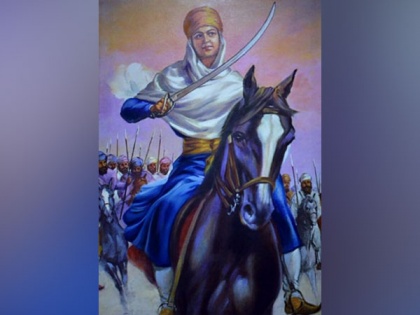The little-known legend of Mai Bhago, a staunch 'Sikhni'
By ANI | Published: May 6, 2023 01:26 PM2023-05-06T13:26:24+5:302023-05-06T13:30:14+5:30
Punjab [India], May 6 : Mai Bhago was undoubtedly a warrior and was well-regarded both within and outside of ...

The little-known legend of Mai Bhago, a staunch 'Sikhni'
Punjab [India], May 6 : Mai Bhago was undoubtedly a warrior and was well-regarded both within and outside of the Sikh community. Hers is a tale of the shining armoured knight who made her sword the symbol of her undying love for her faith and her country, as per Khalsa Vox.
The lioness of Punjab, Mai Bhago, was born as Mata Bhag Kaur. The zealous and harsh rule of the Mughals caused great suffering on the Indian subcontinent in the 17th century. Sikhism, which had carved out a safe place where multitudes believed in equality and were free to practise a faith of their choosing, provided a silver lining to these terrible times.
Let's back up a bit more and peek through the windows of history. Aurangzeb, a brutal despot, governed the Mughals at this time. He reinstated strict Sharia laws and levied discriminatory taxes on Hindus. He was particularly hostile to the Sikhs, mostly because he disagreed with their egalitarian norms that treated women and men equally, Khalsa Vox reported.
Thus starts the story of Mai Bhago's bravery in the battle of Kidhrana, fought on December 29, 1705, between Sikhs headed by Guru Gobind Singhji and the powerful Mughal army, which arrived to capture the Guru and put an end to Sikhism.
Although Mai Bhago's early years are not fully documented, it is known that she was born in the Punjabi village of Jhabal Kalan in the Amritsar area. She was Bhai Malo Shah's only daughter and Bhai Piro Shah's granddaughter. Since the time of Guru Arjan Dev, the family has been devoted to Sikhism. She was married to Sardar Nidhan Singh Warraich.
A massive military campaign was orgsed by Aurangzeb against Guru Gobind Singh, and he dispatched thousands of soldiers to battle a much smaller Sikh force. As the Sikh warriors gradually killed or deserted, Guru Gobind Singhji was forced to seek refuge in hiding, as per Khalsa Vox.
In the meantime, Mai Bhago was receiving military training from her father. Being a staunch 'Sikhni', she was devastated to learn that some of the troops from her own town had betrayed their Guru. Then she decided to take matters into her own hands and convinced them to go back to the Khalsa. The Mughal battalion of hundreds of troops attacked these forty fighters and Mai Bhago as they travelled to the Guru in the vicinity of Anandpur Sahib. Under Mai Bhago's leadership, the Sikhs battled bravely as she charged into the fray wearing a full Khalsa costume, a 'Keski' tied around her head, and a 'kirpan' in her hand.
Her war cry was "Waheguruji Da Khalsa, Waheguruji Di Fateh."
In the true sense of the word, she was Punjab's lioness. Despite losing 39 soldiers in the battle, she and her army were successful in driving the Mughals from their territory, Khalsa Vox report further read.
Only Mahan Singh Brar was barely alive when Guru Gobind Singh arrived on the battlefield. The Khalsa was so moved by their bravery when they had earlier deserted him and renounced their religion, that he tore the paper that he had asked them to sign. He blessed them as "Challi Mukte," or the forty pearls. Later, Mahan Singh died, leaving Mai Bhago with severe injuries. The Khalsa himself took care of her recovery.
As she had lost both her husband and brother in the war, the guru later urged her to return to her village. However, she pleaded with the Khalsa to restore her as a saint-solider so that she may stay with the guru, according to Khalsa Vox.
Her wish was granted, and she continued to serve as one of his bodyguards. Mai Bhago travelled with Guru Gobind Singhji to Nanded and served him until his death in 1708. She then moved to Jinvara in Karnataka, close to Bidar, where she preached Sikhism till she passed away at a ripe old age. The former location of her hut in Jinvara is now home to Gurudwara Tap Asthan Mai Bhago. A hall inside the grounds of Takt Sachkhand Sri Hazur Sahib in Nanded has also been identified as the location of Bunga Mai Bhago.
Mai Bhago's legacy continues to this day as a representation of Sikh courage and pride. Although she is frequently referred to as a "little-known legend," many strong Sikh women continue to be motivated by her example to accept death bravely, Khalsa Vox reported.
Disclaimer: This post has been auto-published from an agency feed without any modifications to the text and has not been reviewed by an editor
Open in app